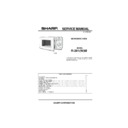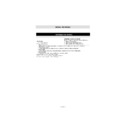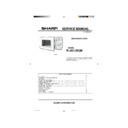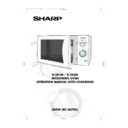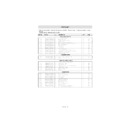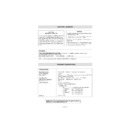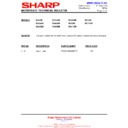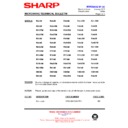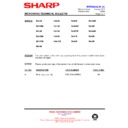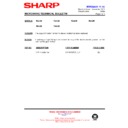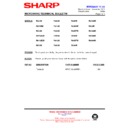Sharp R-201 (serv.man2) Service Manual ▷ View online
R-201M - 5
MICROWAVE OUTPUT POWER (IEC-60705)
The power output of this oven is rated using the method specified by IEC-60705. Full details of how to carry out this
procedure can be found in the Sharp Technical Training notes which is available from Sharp Parts Centre
(part number SERV-LITMW01).
procedure can be found in the Sharp Technical Training notes which is available from Sharp Parts Centre
(part number SERV-LITMW01).
Using this procedure,for an 800W oven, the heating time to raise 1000g of water by 10
°
C is approximately 55 seconds.
The IEC-60705 procedure must be carried out using laboratory-type procedures and equipment. These requirements
make the procedure unsuitable for routing performance checks. An indication of the power being produced by the oven
can however be obtained using the procedure given below.
make the procedure unsuitable for routing performance checks. An indication of the power being produced by the oven
can however be obtained using the procedure given below.
Alternative simplified method:
1. Place 2 litres of cold water (between 12
1. Place 2 litres of cold water (between 12
°
C and 20
°
C) in a suitable container.
2. Stir the water and measure the temperature in
°
C. Note temperature as T1.
3. Place the container in the microwave and heat the water for 2 minutes on full power.
4. When the 2 minutes is completed, remove the container and stir the water. Note the water temperature as T2.
5. Calculate the output power using the following formula:
4. When the 2 minutes is completed, remove the container and stir the water. Note the water temperature as T2.
5. Calculate the output power using the following formula:
R.F. Power Output = (T2 - T1) x 70.
Note: The result from this test should be within 10% of the power rating stated on the rating label.
MICROWAVE LEAKAGE TEST
This oven should be tested for microwave leakage on completion of any repair or adjustment, following the procedure
described in the Sharp Technical Training notes (part number SERV-LITMW01). The maximum leakage permitted in
BS EN 60335-2-25 is 50W/m
described in the Sharp Technical Training notes (part number SERV-LITMW01). The maximum leakage permitted in
BS EN 60335-2-25 is 50W/m
2
(equivalent to 5mW/cm
2
), however it is not normal to detect any significant leakage,
therefore, any leakage which is detected should be investigated.
It is essential that only leakage detectors with current calibration traceable to the National Physical Laboratories are used.
Suitable leakage detectors :
CELTEC A100
APOLLO X1
APOLLO X1
Figure C-4. Switches
OUTPUT POWER TEST PROCEDURE
COMPONENT REPLACEMENT
MONITORED LATCH SWITCH, LATCH
SWITCH, AND MONITOR SWITCH REMOVAL
SWITCH, AND MONITOR SWITCH REMOVAL
1.
CARRY OUT 3D CHECKS.
2.
Disconnect the leads from all switches.
3.
Remove the one (1) screw holding the latch hook to the
oven cavity.
oven cavity.
4.
Remove the latch hook.
5.
Push the retaining tab slightly and remove the switch.
LATCH HOOK
SW3: LATCH
SWITCH
SWITCH
SW1: MONITORED
LATCH SWITCH
LATCH SWITCH
SW2: MONITOR
SWITCH
SWITCH
Tab
Tab
Post
Post
Tab
Post
R-201M - 6
COMPONENT REPLACEMENT
Note: After any service to the door;
(A) Make sure that monitored latch switch,latch
(A) Make sure that monitored latch switch,latch
switch and monitor switch are operating
properly.
properly.
(B) An approved microwave survey meter
should be used to assure compliance with
proper microwave radiation emission
limitation standards
proper microwave radiation emission
limitation standards
DOOR REPLACEMENT
1.
CARRY OUT 3D CHECKS.
2.
Remove choke cover taking care not to break
clips.
clips.
3.
Remove door assembly by lifting and easing
it forward.
it forward.
4.
On re-installation make sure the door is
parallel with the bottom line of the oven face
plate and the latch head pass through the
latch holes correctly.
parallel with the bottom line of the oven face
plate and the latch head pass through the
latch holes correctly.
5.
CARRY OUT 4R CHECKS.
NOTE : After any service to the door, the
approved microwave survey meter should be
used to assure in compliance with proper
microwave radiation standards.
used to assure in compliance with proper
microwave radiation standards.
CHOKE COVER REMOVAL
1.
Insert an iron plate (thickness of about 0.5mm) or
flat type screw driver to the gap between the choke
cover and door panel as shown figure to free the
engaged part. The protect sheet may be used not
to damage the door panel.
flat type screw driver to the gap between the choke
cover and door panel as shown figure to free the
engaged part. The protect sheet may be used not
to damage the door panel.
2.
Lift up the choke cover, now the coke cover is free.
Finger tab
Door film
Backing film
DOOR ASSEMBLY
OUTER CASE
CABINET
CABINET
LATCH HEADS
Figure C-6. Door Assembly Replacement and
Adjustment
NOTE: When carring out any repair to the door,
do not bend or warp the slit choke (tabs on
the door panel assembly) to prevent
microve leakage.
the door panel assembly) to prevent
microve leakage.
FLAT TYPE
SCREW-DRIVER
SCREW-DRIVER
PROTECT BY TAPE
CHOKE
COVER
COVER
DOOR
PANEL
PANEL
OUTER DOOR FILM
Removal
1. Remove the door film from the clips on the door frame.
Installation
1. Attach the door film to the clips on the door frame.
1. Attach the door film to the clips on the door frame.
Adhesive tape
Finger tab
Door film
Backing film
INNER DOOR FILM
Removal
1.
1.
Tear the door film from the door panel.
2.
Now the door film is free.
Installation
1.
1.
Tear away the backing film.
2.
Put the pasted side of the door film on the door
panel.
panel.
LATCH HEAD REMOVAL
1.
1.
Remove the choke as above.
2.
Unhook the spring and lift the latch head clear.
3.
Replacement, the reverse of the above.
NOTE: When carring out any repair to the door,
do not bend or warp the slit choke (tabs on
the door panel assembly) to prevent
microve leakage.
the door panel assembly) to prevent
microve leakage.
SLIT CHOKE
R-201M - 7
MICROWAVE MEASUREMENT
After any repair, the microwave oven must be checked for microwave leakage to ensure continued safe operation. BS EN
60335-2-25 specifies that the maximum permitted leakage with a load of 275 ml is 50 W/m
60335-2-25 specifies that the maximum permitted leakage with a load of 275 ml is 50 W/m
2
(equivalent to 5 mW/cm
2)
at a
distance of 5 cm from the oven.
PREPARATION
The following items are required to carry out this test:-
1. A low form of 600 ml beaker made from an electrically non-conductive material, such as glass or plastic, with an inside
1. A low form of 600 ml beaker made from an electrically non-conductive material, such as glass or plastic, with an inside
diameter of approximately 8.5 cm. This must contain 275
±
15 ml of water, at an initial temperature of 20
±
2˚C.
2. A leakage detector which has been calibrated within the preceding 12 months to a standard whose accuracy can be
traced to National Physical Laboratory Standards.
Recommended instruments are:
Apollo “XI”
Celtec “A100”
Celtec “A100”
Before commencing the test, check that the leakage detector is functioning and adjusted according to the manufacturer’s
instructions, and any spacers are fitted to ensure that measurement is taken 5cm from the surface of the oven.
instructions, and any spacers are fitted to ensure that measurement is taken 5cm from the surface of the oven.
PROCEDURE
1. Place the beaker containing the water load in the oven cavity at the centre of the turntable. The placing of this standard
load in the oven is important, not only to protect the oven, but also to ensure that any leakage it is not disguised by too
large a load absorbing energy.
large a load absorbing energy.
2. Close the oven door, and with the power level set to FULL, turn the oven ON with the timer set for a few minutes operation.
Should the water begin to boil before the test has been completed, it should be replaced.
3. As shown in the diagram below, move the probe slowly (not faster than 2.5 cm/sec.);-
a) around the edge of the door following the gap
b) across the face of the door
c) across any vents in the oven’s sides, rear or top
a) around the edge of the door following the gap
b) across the face of the door
c) across any vents in the oven’s sides, rear or top
Dotted line indicates the path by the leakage detector.
Whilst the maximum leakage permitted in BS60335 2-25 is 50 /W/m
2
(equivalent to 5 W/cm
2
),it is not normal to detect any
significant leakage, and therefore any detected leakage should be investigated.
R-201M - 7
MICROWAVE MEASUREMENT
After any repair, the microwave oven must be checked for microwave leakage to ensure continued safe operation. BS EN
60335-2-25 specifies that the maximum permitted leakage with a load of 275 ml is 50 W/m
60335-2-25 specifies that the maximum permitted leakage with a load of 275 ml is 50 W/m
2
(equivalent to 5 mW/cm
2)
at a
distance of 5 cm from the oven.
PREPARATION
The following items are required to carry out this test:-
1. A low form of 600 ml beaker made from an electrically non-conductive material, such as glass or plastic, with an inside
1. A low form of 600 ml beaker made from an electrically non-conductive material, such as glass or plastic, with an inside
diameter of approximately 8.5 cm. This must contain 275
±
15 ml of water, at an initial temperature of 20
±
2˚C.
2. A leakage detector which has been calibrated within the preceding 12 months to a standard whose accuracy can be
traced to National Physical Laboratory Standards.
Recommended instruments are:
Apollo “XI”
Celtec “A100”
Celtec “A100”
Before commencing the test, check that the leakage detector is functioning and adjusted according to the manufacturer’s
instructions, and any spacers are fitted to ensure that measurement is taken 5cm from the surface of the oven.
instructions, and any spacers are fitted to ensure that measurement is taken 5cm from the surface of the oven.
PROCEDURE
1. Place the beaker containing the water load in the oven cavity at the centre of the turntable. The placing of this standard
load in the oven is important, not only to protect the oven, but also to ensure that any leakage it is not disguised by too
large a load absorbing energy.
large a load absorbing energy.
2. Close the oven door, and with the power level set to FULL, turn the oven ON with the timer set for a few minutes operation.
Should the water begin to boil before the test has been completed, it should be replaced.
3. As shown in the diagram below, move the probe slowly (not faster than 2.5 cm/sec.);-
a) around the edge of the door following the gap
b) across the face of the door
c) across any vents in the oven’s sides, rear or top
a) around the edge of the door following the gap
b) across the face of the door
c) across any vents in the oven’s sides, rear or top
Dotted line indicates the path by the leakage detector.
Whilst the maximum leakage permitted in BS60335 2-25 is 50 /W/m
2
(equivalent to 5 W/cm
2
),it is not normal to detect any
significant leakage, and therefore any detected leakage should be investigated.
Display

